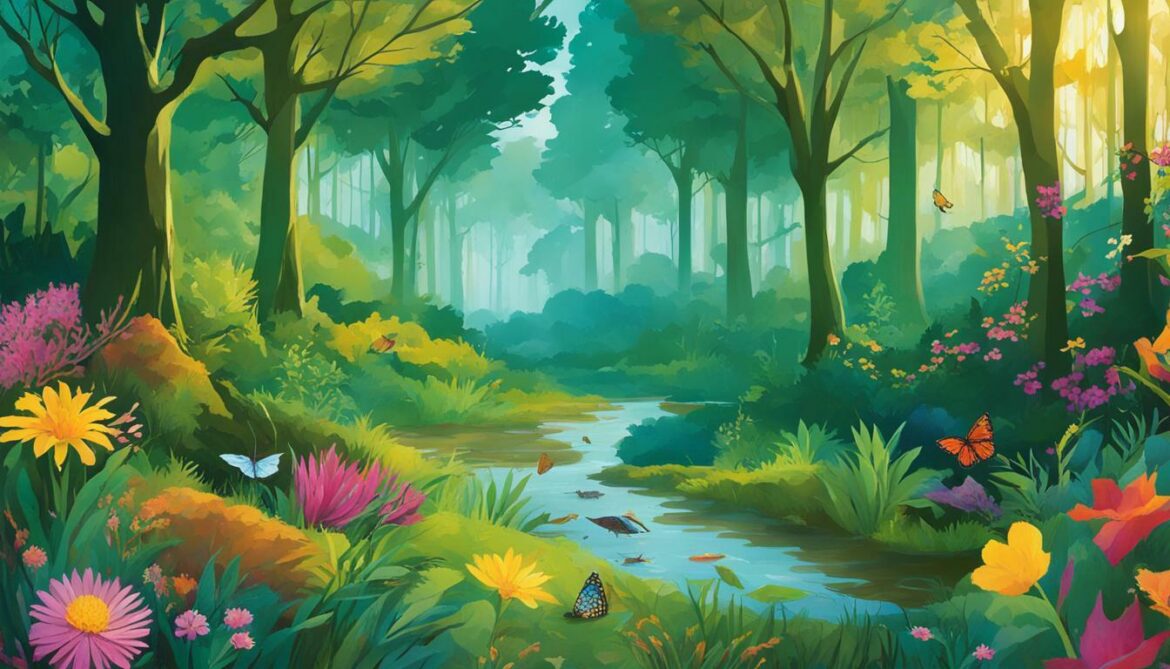Nature restoration and biodiversity net gain are crucial for preserving England’s natural environment and promoting sustainable land management. These initiatives play a vital role in protecting and enhancing the country’s rich biodiversity, ensuring the survival of various species and the maintenance of healthy ecosystems. In England, Homes England, the government’s housing and regeneration agency, is at the forefront of implementing biodiversity net gain in their development schemes.
Homes England recognizes the importance of creating and enhancing habitats for wildlife while providing green spaces that benefit local communities. They use a tool called the Biodiversity Metric to measure the value of habitats and prioritize the avoidance of negative impacts on valuable habitats.
However, implementing biodiversity net gain in existing projects poses challenges for Homes England. Retrofitting biodiversity net gain obligations to schemes acquired before considering such requirements requires careful planning and consideration of the potential impacts on ongoing projects.
Key Takeaways:
- Nature restoration and biodiversity net gain are vital for preserving England’s natural environment.
- Homes England is actively implementing biodiversity net gain in their development schemes.
- The Biodiversity Metric is used to measure the value of habitats and prioritize conservation efforts.
- Retrofitting biodiversity net gain obligations to existing projects presents challenges.
- Mandatory biodiversity net gain is expected to become effective from January 2024.
The Importance of Nature Restoration and Biodiversity Net Gain
Nature restoration and biodiversity net gain play a vital role in conserving the environment, preserving natural habitats, restoring ecosystems, and protecting wildlife in England. These initiatives aim to enhance the quality and quantity of biodiversity across the country, ensuring the long-term sustainability of our ecosystems.
Environmental conservation is a key goal of nature restoration and biodiversity net gain. By restoring and creating habitats, we can provide safe spaces for plants, animals, and insects to thrive. This not only maintains the delicate balance of ecosystems but also contributes to the overall health of our environment.
Natural habitat preservation is another crucial aspect of these initiatives. By safeguarding existing habitats from destruction and degradation, we can protect the various species that depend on them. From woodlands to wetlands, these habitats provide essential resources and shelter for wildlife, helping to maintain biodiversity.
Ecosystem restoration is an integral part of nature restoration and biodiversity net gain. By repairing damaged ecosystems, we can bring back the natural processes and functions that support a healthy environment. This includes restoring waterways, planting native vegetation, and reintroducing key species, all of which contribute to the overall resilience of our ecosystems.
| Benefits of Nature Restoration and Biodiversity Net Gain |
| Enhances biodiversity |
| Improves ecosystem services |
| Promotes climate resilience |
| Enhances human well-being |
“Conservation is a state of harmony between men and land.” – Aldo Leopold
Therefore, nature restoration and biodiversity net gain are not only essential for the well-being of our planet but also for the well-being of future generations. By prioritizing the protection and enhancement of our natural environment, we can create a sustainable future that benefits both wildlife and humans alike.

One notable success story in achieving biodiversity net gain is the Brookleigh development in West Sussex. Through careful planning and implementation, this project is predicted to achieve a remarkable 23% net gain. By incorporating green infrastructure, enhancing existing habitats, and creating new ones, the development has become a model for sustainable urban planning.
As we move towards the mandatory implementation of biodiversity net gain from January 2024, it is important for developers, local authorities, and communities to embrace these initiatives. By working together, we can ensure a greener and more sustainable future for England, where nature thrives and wildlife flourishes.
Homes England’s Role in Biodiversity Net Gain
Homes England actively promotes biodiversity net gain through the creation of habitats for wildlife and the development of green spaces, using the Biodiversity Metric as a tool to assess habitat value. As the government’s housing and regeneration agency, Homes England plays a crucial role in implementing biodiversity net gain in their schemes, ensuring that development projects have a positive impact on the natural environment.

One of Homes England’s key objectives is to enhance the biodiversity value of their developments by prioritizing the avoidance of impacts on valuable habitats. They strive to create and enhance habitats that support a diverse range of species, while also providing accessible green spaces for communities to enjoy. By using the Biodiversity Metric, they can measure the value of habitats and ensure that their projects achieve a net gain in biodiversity.
Homes England faces challenges in retrofitting biodiversity net gain obligations to schemes that were acquired before considering such requirements. However, through their experience in delivering various schemes, they have been able to build knowledge and expertise in achieving biodiversity net gain. The Brookleigh development in West Sussex is an example of their success story, with a predicted 23% net gain. This project showcases the positive outcomes of implementing biodiversity net gain and demonstrates the potential for future developments to contribute to the enhancement of the natural environment.
Challenges Faced by Homes England in Retrofitting Biodiversity Net Gain
Retrofitting biodiversity net gain obligations to existing schemes poses challenges for Homes England in meeting the new requirements. As the government’s housing and regeneration agency, Homes England is committed to creating and enhancing habitats for wildlife while providing green spaces for communities. However, integrating biodiversity net gain into pre-existing projects presents unique obstacles.
One of the main challenges is the difficulty in implementing these obligations without disrupting ongoing development plans. Retrofitting biodiversity net gain requires careful consideration of existing designs and may require adjustments to accommodate the preservation and enhancement of habitats. It also necessitates a comprehensive understanding of the Biodiversity Metric, which measures the value of habitats and guides conservation strategies.
To overcome these challenges, Homes England is actively working to build experience in delivering biodiversity net gain. By learning from successful projects, such as the Brookleigh development in West Sussex, they are developing best practices and strategies to overcome potential obstacles. The Brookleigh development is a shining example of achieving net gain, with a predicted 23% increase in biodiversity.
Through diligent planning and collaboration with stakeholders, Homes England aims to navigate the complexities of retrofitting biodiversity net gain. This process requires balancing the protection and enhancement of habitats with the existing development plans. By leveraging their expertise and engaging in ongoing learning, Homes England is paving the way for successful implementation of mandatory biodiversity net gain in England.

The Brookleigh development in West Sussex serves as an exemplary case, with a predicted net gain of 23% and significant positive outcomes in biodiversity enhancement. This residential project, undertaken by Homes England, showcases the successful implementation of biodiversity net gain principles. The development prioritizes the creation and enhancement of habitats for wildlife, while also providing high-quality green spaces for the local community.

“The Brookleigh development stands as a testament to the commitment and dedication shown by Homes England in achieving biodiversity net gain. It serves as a model for sustainable development, where nature restoration and ecological enhancement go hand in hand with creating vibrant, livable communities.”
By incorporating the Biodiversity Metric, Homes England ensures that the value of habitats is measured accurately, helping to prioritize the avoidance of impacts on valuable ecosystems. The Brookleigh development demonstrates how these measures can be successfully integrated into residential projects, resulting in a significant net gain in biodiversity across the site.
Positive Outcomes of the Brookleigh Development
| Enhanced Biodiversity |
Creation of Green Spaces |
Improved Ecological Connectivity |
| The project has led to an increase in native flora and fauna species, promoting a healthier ecosystem. |
The development provides well-designed green spaces, encouraging community engagement and enhancing residents’ quality of life. |
By creating corridors and linkages between habitats, the development enhances ecological connectivity, enabling wildlife to move more freely. |
The success of the Brookleigh development highlights the positive impact that biodiversity net gain can have on both the natural environment and local communities. It serves as a demonstration of how sustainable land management practices can be integrated into residential developments, ensuring that future generations can enjoy a thriving and biodiverse landscape.
Mandatory Biodiversity Net Gain from January 2024
Starting from January 2024, mandatory biodiversity net gain will be implemented in England as outlined in the Environment Act 2021, requiring a minimum 10% net gain using the Biodiversity Metric and long-term habitat protection. This landmark legislation aims to ensure that development projects contribute to the enhancement and conservation of biodiversity, not just in the immediate vicinity, but also at a national level.
Under the new regulations, developers will be required to measure the biodiversity value of a site before development begins, using the Biodiversity Metric. This tool assesses the quality and quantity of habitats, as well as the presence of protected and priority species. The target of achieving a minimum 10% net gain means that the biodiversity value of the site after development must be 10% higher than its pre-development value.
Long-term habitat protection is another important aspect of the mandatory biodiversity net gain requirements. Developers will need to secure habitats for at least 30 years, ensuring their ongoing conservation and management. This will help to safeguard biodiversity and ecosystem services for future generations, while also promoting sustainable land management practices.

| Key Points: |
Details: |
| Implementation Date |
From January 2024 |
| Minimum Net Gain |
10% using the Biodiversity Metric |
| Long-term Habitat Protection |
Secure habitats for at least 30 years |
The Environment Act 2021 also includes provisions for a national biodiversity credits scheme. This scheme allows developers to purchase credits if on-site or off-site net gains cannot be achieved. By enabling the sale of credits, the scheme provides flexibility and ensures that the mandatory biodiversity net gain requirements can be met effectively.
Support and Resources for Successful Implementation
“We are committed to supporting local authorities and developers in successfully implementing mandatory biodiversity net gain. Through our partnership with Defra, we provide resources, training, and support to help build capacity and skills,” said a spokesperson from PAS.
PAS, an organization commissioned by Defra, offers comprehensive guidance and assistance to local authorities and developers in navigating the complexities of mandatory biodiversity net gain. They provide training sessions, access to resources and tools, and consultancy services to ensure a smooth transition and successful implementation of the new requirements.
By working together, local authorities, developers, and organizations like PAS can ensure that mandatory biodiversity net gain becomes an integral part of sustainable development in England. This will not only help protect and enhance biodiversity but also contribute to the creation of healthier, more resilient communities.
Role of Local Authorities in Preparing for Mandatory Biodiversity Net Gain
Local authorities have a pivotal role in preparing for mandatory biodiversity net gain, encompassing planning decision-making, council services, and the integration of net gain with broader environmental goals. As the implementation of biodiversity net gain becomes a requirement from January 2024, it is crucial for local authorities to proactively adapt their policies and processes to align with these new obligations.
Integrating net gain into planning decision-making is of utmost importance to ensure that development projects prioritize the protection and enhancement of biodiversity. Local authorities need to assess the potential impacts of proposed developments on habitats and species, and work closely with developers to design projects that achieve a minimum 10% net gain using the Biodiversity Metric. This means securing habitats for at least 30 years, ensuring their long-term viability for wildlife.
Council services across different departments also need to embrace the concept of net gain and incorporate it into their strategies. This includes considerations of climate and ecological emergencies, place-making, and green infrastructure. By aligning their policies and actions with the goals of biodiversity net gain, local authorities can contribute to the creation of sustainable, nature-rich communities that benefit both people and wildlife.
To support local authorities in this transition, PAS (Planning Advisory Service), commissioned by Defra, offers a range of resources, training, and support. These resources are designed to help local authorities build knowledge and capacity on biodiversity net gain and develop the skills necessary for successful implementation. By availing themselves of these opportunities, local authorities can confidently navigate the challenges and seize the opportunities presented by mandatory biodiversity net gain.

In summary, local authorities play a vital role in preparing for mandatory biodiversity net gain in England. By integrating net gain into planning decision-making, adopting a cross-departmental approach, and considering the links to climate and ecological emergencies, place-making, and green infrastructure, they can ensure the successful implementation of these initiatives. PAS provides invaluable support and resources to assist local authorities in navigating this transition and building the necessary capacity and skills. Together, local authorities and Homes England can contribute to the protection and enhancement of biodiversity, creating a sustainable future for both people and the natural environment.
Planning Ahead and Avoiding a Rush of Non-Net Gain Applications
Planning ahead and proactive preparation are crucial for local authorities to meet the new legal requirements of mandatory biodiversity net gain and prevent a surge in non-net gain planning applications. With the implementation of mandatory biodiversity net gain approaching in January 2024, local authorities must be ready to ensure a smooth transition and uphold the conservation goals set by the Environment Act 2021.
To effectively prepare, local authorities need to integrate net gain considerations into their planning decision-making processes. This means adopting a broader approach that looks beyond individual development projects and considers the wider ecological and environmental impacts. By doing so, local authorities can ensure that future developments align with climate and ecological emergency objectives while creating sustainable, green spaces.
Linking biodiversity net gain with place-making and green infrastructure initiatives is also essential. Designing developments that enhance local ecosystems, provide green spaces for communities, and contribute positively to the overall environment will result in a more sustainable and harmonious urban landscape. By incorporating these elements into planning strategies early on, local authorities can avoid a last-minute rush of non-net gain applications that could potentially undermine conservation efforts.

Local authorities should take advantage of the support and resources available to aid in the successful implementation of biodiversity net gain. The Planning Advisory Service (PAS), commissioned by Defra, offers training, resources, and assistance tailored to the needs of local authorities. By utilizing these tools, local authorities can build the capacity and skills necessary to navigate the complexities of biodiversity net gain and ensure compliance with the new legislation.
Key Considerations for Local Authorities:
- Integrate net gain into planning decision-making processes
- Adopt a broader approach that considers climate and ecological emergencies, place-making, and green infrastructure
- Design developments that enhance local ecosystems and provide high-quality green spaces
- Seek support and resources from the Planning Advisory Service (PAS) for training and guidance
By effectively planning ahead and considering the implications of mandatory biodiversity net gain, local authorities can play a vital role in safeguarding the natural environment and promoting sustainable land management practices for future generations.
| Key Actions |
Benefits |
| Integrate net gain into planning decision-making processes |
– Ensures environmental considerations are central to future development plans
– Allows for the creation of sustainable, green spaces for communities |
| Adopt a broader approach |
– Considers climate and ecological emergencies, place-making, and green infrastructure
– Results in a more holistic and environmentally conscious urban landscape |
| Design developments that enhance local ecosystems |
– Promotes biodiversity and the preservation of natural habitats
– Creates a positive impact on local ecosystems and wildlife populations |
| Seek support and resources from PAS |
– Access to training, resources, and guidance tailored to the needs of local authorities
– Builds capacity and skills for successful implementation of biodiversity net gain |
Support and Resources from PAS for Successful Implementation
PAS, commissioned by Defra, offers valuable resources, training, and support to local authorities to successfully implement biodiversity net gain and build the necessary capacity and skills. With their expertise in environmental conservation and sustainable land management, PAS is dedicated to assisting local authorities in meeting the requirements of mandatory net gain and ensuring the long-term protection and enhancement of biodiversity in England.
PAS provides comprehensive resources that cover various aspects of implementing biodiversity net gain. Their extensive library of guidance documents, case studies, and best practice examples equips local authorities with the knowledge and tools needed to navigate the complexities of net gain calculations, habitat creation, and monitoring.
In addition to resources, PAS offers tailored training programs to enhance the skills of local authority staff involved in net gain implementation. These training sessions cover topics such as the Biodiversity Metric, biodiversity offsetting, and effective engagement with developers and stakeholders. By equipping individuals with the necessary knowledge and skills, PAS ensures that local authorities have the expertise to make informed decisions and effectively manage biodiversity net gain within their jurisdictions.
Furthermore, PAS provides ongoing support to local authorities throughout the implementation process. Their team of experts is available to answer queries, provide guidance on specific challenges, and assist in developing bespoke strategies and action plans. By offering this personalized support, PAS empowers local authorities to overcome obstacles and successfully integrate biodiversity net gain into their planning and development processes.

| Benefits of PAS Support and Resources: |
| Access to comprehensive guidance documents, case studies, and best practice examples |
| Tailored training programs covering key aspects of net gain implementation |
| Personalized support from a team of experts |
| Enhanced capacity and skills to implement biodiversity net gain effectively |
Conclusion
Nature restoration and biodiversity net gain are essential for preserving England’s biodiversity, and ongoing efforts are necessary to protect and enhance the natural environment through initiatives such as biodiversity offsetting. Homes England, the government’s housing and regeneration agency, plays a crucial role in implementing biodiversity net gain in their schemes, creating and enhancing habitats for wildlife while providing green spaces for communities. They use the Biodiversity Metric to measure habitat value and prioritize the avoidance of impacts on valuable habitats.

Homes England is already building experience in delivering biodiversity net gain through various schemes, such as the Brookleigh development in West Sussex, which is predicted to achieve a remarkable 23% net gain. This success story demonstrates the positive outcomes of implementing biodiversity net gain, showcasing the potential for sustainable land management practices and the restoration of valuable ecosystems.
The implementation of mandatory biodiversity net gain, starting from January 2024, will require development projects to achieve a minimum 10% net gain using the Biodiversity Metric. These projects must secure habitats for at least 30 years, ensuring the long-term preservation of biodiversity. The Environment Act 2021 also introduces provisions for a national biodiversity credits scheme, allowing the sale of credits to developers if net gains cannot be achieved on-site or through the off-site market.
Local authorities have a crucial role to play in preparing for mandatory biodiversity net gain. They need to integrate net gain into their planning decision-making process, adopt a broader approach across council services, and consider the links to climate and ecological emergencies, place-making, and green infrastructure. By planning ahead and starting early, local authorities can ensure they are ready to meet the upcoming legal requirements and avoid a rush of non-net gain planning applications.
Support and Resources from PAS for Successful Implementation
To assist local authorities in this journey, PAS, an organization commissioned by Defra, offers valuable resources, training, and support. They provide assistance in building capacity and skills, enabling local authorities to navigate the implementation of biodiversity net gain successfully. Through collaboration and the exchange of knowledge, PAS aims to empower local authorities to meet their biodiversity goals and contribute to the preservation of England’s natural environment.
| Key Points |
Benefits |
| Implementing biodiversity net gain |
Protects and enhances natural habitats |
| Mandatory biodiversity net gain |
Ensures a minimum 10% net gain and 30-year habitat security |
| National biodiversity credits scheme |
Enables the sale of credits for off-site net gain |
| Role of local authorities |
Integrating net gain into decision-making and planning |
| Support from PAS |
Resources, training, and assistance for successful implementation |
Conclusion
In conclusion, nature restoration and biodiversity net gain are critical aspects of environmental conservation and sustainable land management in England, ensuring the preservation and enhancement of the country’s natural habitats. Homes England, the government’s housing and regeneration agency, is actively implementing biodiversity net gain in their schemes, creating and enhancing habitats for wildlife while providing green spaces for communities. They utilize the Biodiversity Metric to measure habitat value and prioritize the avoidance of impacts on valuable habitats.
Despite facing challenges in retrofitting biodiversity net gain obligations to existing schemes, Homes England is gaining experience in delivering successful biodiversity net gain projects, such as the Brookleigh development in West Sussex, which is predicted to achieve a 23% net gain. Looking ahead, the implementation of mandatory biodiversity net gain from January 2024 will require development projects to achieve a minimum 10% net gain using the Biodiversity Metric and secure habitats for at least 30 years.
The Environment Act 2021 introduces provisions for a national biodiversity credits scheme, allowing the sale of credits to developers if net gains cannot be achieved onsite or through off-site options. Local authorities play a crucial role in preparing for mandatory biodiversity net gain, integrating it into planning decision-making and adopting a broader approach across council services. Considering the links to climate and ecological emergencies, place-making, and green infrastructure is essential in their planning processes.
To ensure a smooth transition and avoid a rush of non-net gain planning applications, planning ahead is vital. Local authorities should be ready to meet the new legal requirements and effectively implement biodiversity net gain. PAS, an organization commissioned by Defra, offers resources, training, and support to help local authorities navigate this journey, build capacity, and acquire the necessary skills for successful implementation.
FAQ
What is nature restoration and biodiversity net gain?
Nature restoration refers to the process of restoring and enhancing natural habitats and ecosystems to their original or improved state. Biodiversity net gain, on the other hand, is a concept that aims to ensure development projects result in a net gain of biodiversity, meaning they contribute more to biodiversity than what is lost or impacted.
Why is nature restoration and biodiversity net gain important?
Nature restoration and biodiversity net gain are important initiatives to protect and enhance the natural environment. They contribute to the conservation of habitats and species, help restore ecosystems, and promote sustainable land management. By prioritizing these goals, we can preserve biodiversity for future generations.
What is Homes England’s role in biodiversity net gain?
Homes England, the government’s housing and regeneration agency, is actively implementing biodiversity net gain in their schemes. They aim to create and enhance habitats for wildlife while providing high-quality green spaces for communities. They use the Biodiversity Metric to measure habitat value and prioritize the avoidance of impacts on valuable habitats.
What challenges does Homes England face in retrofitting biodiversity net gain?
Homes England faces challenges in retrofitting biodiversity net gain obligations to schemes acquired prior to considering such requirements. It can be difficult to implement these obligations to existing projects, but Homes England is gaining experience in delivering biodiversity net gain through various schemes.
Can you provide an example of a successful biodiversity net gain project?
The Brookleigh development in West Sussex is a success story in achieving biodiversity net gain. It is predicted to achieve a 23% net gain, showcasing the positive outcomes of implementing biodiversity net gain in development projects.
When will mandatory biodiversity net gain become effective?
Mandatory biodiversity net gain is expected to become effective from January 2024. Development projects will be required to achieve a minimum 10% net gain using the Biodiversity Metric and secure habitats for at least 30 years.
How will the Environment Act 2021 support biodiversity net gain?
The Environment Act 2021 includes provisions for a national biodiversity credits scheme. This scheme allows the sale of credits to developers if net gains cannot be achieved on-site or through the off-site market, providing an alternative pathway to meet net gain requirements.
What is the role of local authorities in preparing for mandatory biodiversity net gain?
Local authorities play a crucial role in preparing for mandatory biodiversity net gain. They need to integrate net gain into planning decision-making, adopt a broader approach across council services, and consider the links to climate and ecological emergencies, place-making, and green infrastructure.
How can local authorities avoid a rush of non-net gain planning applications?
Planning ahead and starting early is essential for local authorities to ensure they are ready to meet the new legal requirements. By adopting a proactive approach and considering biodiversity net gain in their planning processes, they can avoid a rush of non-net gain planning applications.
Where can local authorities find support and resources for implementing biodiversity net gain?
PAS, an organization commissioned by Defra, offers resources, training, and support to help local authorities navigate the journey of implementing biodiversity net gain. They provide assistance in building capacity and skills for successful implementation.
Source Links



























Post comments (0)